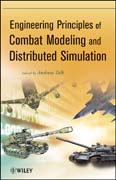
Engineering principles of combat modeling and distributed simulation
Tolk, Andreas
Explore the military and combat applications of modeling and simulation Engineering Principles of Combat Modeling and Distributed Simulation is the first book of its kind to address the three perspectives that simulation engineers must master for successful military and defense related modeling: the operational view (what needs to be modeled); the conceptual view (how to do combat modeling); and the technical view (how to conduct distributed simulation). Through methods from the fields of operations research, computer science, and engineering, readers are guided through the history, current training practices, and modern methodology related to combat modeling and distributed simulation systems. Comprised of contributions from leading international researchers and practitioners, this book provides a comprehensive overview of the engineering principles and state-of-the-art methods needed to address the many facets of combatmodeling and distributed simulation and features the following four sections:Foundations introduces relevant topics and recommended practices, providing the needed basis for understanding the challenges associated with combat modeling and distributed simulation. Combat Modeling focuses on the challenges in human, social, cultural, and behavioral modeling such as the core processes of 'move, shoot, look, and communicate' within a synthetic environment and also equips readers with the knowledge to fully understand the related concepts and limitations. Distributed Simulation introduces the main challenges of advanced distributed simulation, outlines the basics of validation and verification, and exhibits how these systems can support the operational environment of the warfighter. Advanced Topics highlights new and developing special topic areas, including mathematical applications fo combat modeling; combat modeling with high-level architecture and base object models; and virtual and interactive digital worlds. Featuring practical examples and applications relevant to industrial and government audiences, Engineering Principles of Combat Modeling and Distributed Simulation is an excellent resource for researchers and practitionersin the fields of operations research, military modeling, simulation, and computer science. Extensively classroom tested, the book is also ideal for courseson modeling and simulation; systems engineering; and combat modeling at the graduate level. ANDREAS TOLK, PhD, is Professor in the Department of Engineering Management and Systems Engineering at Old Dominion University. He supported the development of the discipline of modeling and simulation with his publications for the SImulation Interoperability Workshops as well as his contributions to his various NATO research activities in the domains of combat modeling, command and control, and studies and analysis. INDICE: Preface List of Authors Table Contents Chapter 1. Challenges of Combat Modeling and Distributed Simulation Part I. Foundations Chapter 2. Applicable Codes of Ethics Chapter 3. The NATO Code of Best Practice for Command andControl Assessment Chapter 4. Terms and Application Domains Chapter 5. Scenario Elements Part II. Combat Modeling Chapter 6. Modeling the Environment Chapter 7. Modeling Movement Chapter 8. Modeling Sensing Chapter 9. Modeling Effects Chapter 10. Modeling Communication, Command and Control Part III. Distributed Simulation Chapter 11. Challenges of Distributed Simulation Chapter 12. Standards for Distributed Simulation Chapter 13. Modeling and Simulation Development and Preparation Processes Chapter 14. Validation and Verification Chapter 15. Integration of M&S Solutions into the Operational Environment Part IV. Advanced Topics Chapter 16. History of Combat Modeling and Distributed Simulation M. L. Loper & C. D. Turnitsa Chapter 17. Serious Games, Virtual Worlds, and Interactive Digital Worlds R. Smith Chapter 18. Mathematical Applications for Combat Modeling P.T. Hester & A. Collins Chapter 19. Combat Modeling with the High Level Architecture and Base Object Models M. D. Petty & P. Gustavson Chapter 20. Test and Training Enabling Architecture (TENA) E. T. Powell & J. R. Noseworthy Chapter 21. Combat Modeling using the DEVs Formalism I.-C. Moon & T.G. Kim Chapter 22. GIS Data for Combat Modeling J.D. Lashlee, J.L. Bricio, R. Holcomb & W.T. Richards Chapter 23. Modeling Tactical Data Links J. Sorroche Chapter 24. Standards-Based Combat Simulation Initialization using the Military Scenario Definition Language (MSDL) R.L. Wittman Chapter 25. Multi-Resolution Combat Modeling M.D. Petty, R.W. Franceschini & J. Panagos Chapter 26. New Challenges: Human, Social, Cultural, and Behavioral Modeling S.K. Numrich & P.M. Picucci Chapter 27. Agent-directed Simulation for Combat Modeling and Distributed Simulation G.K. Bharathy & L. Yilmaz Chapter 28. Uncertainty Representation and Reasoning for Combat Models P.C.G. Costa, H. Herencia-Zapana, K.B. Laskey Chapter 29. Model-based Data Engineering for Distributed Simulations S.Y. Diallo Chapter 30. Federated Simulation for System of Systems Engineering R. H. Kewley & M.D. Wood Chapter 31. The Role of Architecture Frameworks in SimulationModels: The Human View Approach H.A.H. Handley Chapter 32. Multinational Computer Assisted Exercises E. Cayirci Annex Annex 1. M&S Organizations/Associations S. Chemlal & T. Ören Annex 2. Military Simulation Systems J.J. Padilla Resume of Contributors Acknowledgements
- ISBN: 978-0-470-87429-5
- Editorial: John Wiley & Sons
- Encuadernacion: Cartoné
- Páginas: 900
- Fecha Publicación: 02/03/2012
- Nº Volúmenes: 1
- Idioma: Inglés
